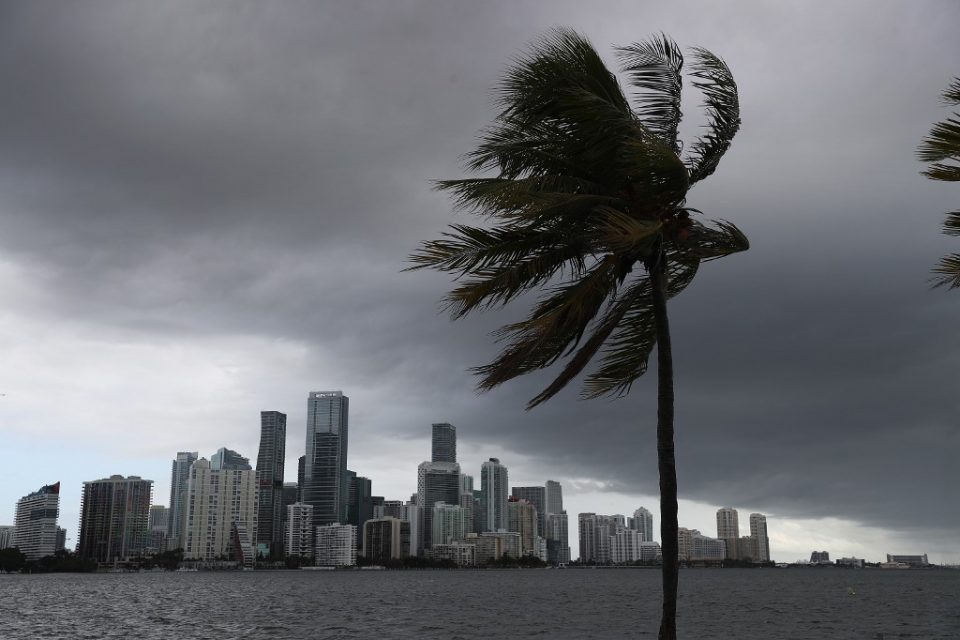
Tropical storm Isaias, downgraded from a category 1 hurricane, was packing sustained winds of 65 miles (105 kilometers) per hour on Sunday afternoon, the National Hurricane Center (NHC) said. (Photo by JOE RAEDLE / GETTY IMAGES NORTH AMERICA / AFP)
by Leila MACOR
MIAMI, United States (AFP) — Isaias roared closer to the Florida coast Sunday, threatening to bring strong winds, flash flooding and storm surges but no longer expected to regain hurricane strength.
The tropical storm was packing sustained winds of 70 miles (110 kilometers) per hour Sunday evening as it moved northwest off the state’s east coast, the National Hurricane Center (NHC) said.
Florida’s coast was experiencing heavy wind gusts. The NHC said “some fluctuations in strength” are possible in the next two days, but Isaias is not expected to regain its hurricane status.
At 8:00 pm, the storm was 55 miles (90 kilometers) from America’s Cape Canaveral space center, moving northwest at nine miles per hour, the Miami-based NHC said.
It said the center of Isaias was expected to move “near or over the east coast of Florida today through late tonight” before moving on Monday and Tuesday into the Atlantic.
The storm earlier dumped torrential rain on the Bahamas, felling trees and flooding some streets, before emergency management officials on Sunday gave the “all clear” for the entire country. But Isaias claimed at least one life in Puerto Rico.
Tropical storm warnings were in effect from central-eastern Florida to North Carolina, and the NHC warned on Twitter that Isaias could “bring a storm surge of up to 4 feet to coastal parts of South and North Carolina.”
As Florida battened down, it was also battling its coronavirus outbreak, which has complicated preparations.
It has the second-highest caseload of all states except California — which has double the population.
On Sunday, Florida reported 62 COVID-19 deaths, down from a record 179 the day before, bringing its total to 7,206.
The storm has even had an impact beyond Earth, with NASA closely monitoring it before finally giving the green light to the SpaceX Crew Dragon craft to return two astronauts from the International Space Station.
The craft splashed down Sunday afternoon in a decidedly calm Gulf of Mexico — hundreds of miles west of Isaias’s track — and was successfully retrieved by SpaceX’s specialized GO Navigator vessel.
‘A good test’
Earlier, as the storm approached, Florida residents had rushed to stock up on essentials. Coronavirus testing centers, many housed in tents, were closed Thursday and will not reopen until they get the all-clear after the storm.
The state emergency management director, Jared Moskowitz, said “this was a really good test of a lot of the new protocols and procedures that have been put in place here in the state of Florida (to) battle a hurricane season with COVID-19.”
He said hotels had been set up so those seeking shelter could maintain social distancing, or to serve as shelters for people who had tested positive for the virus.
“It looks like we’re (in) really good shape, but we’re not declaring mission accomplished until this thing is away from us,” he told CNN.
Isaias on Thursday unleashed destruction in Puerto Rico, downing trees and electrical lines and inundating houses as it cut a path through the island.
Authorities there said Saturday they had recovered the body of a 56-year-old woman whose car had been swept away by storm waters.
In the Bahamas, the deputy director of the country’s meteorology department, Jeffrey Simmons, told The Nassau Guardian “the worst part” of the storm came to New Providence, the most populous island, early Saturday.
It was the archipelago’s first hurricane since Dorian, a Category 5 storm last year that devastated two islands, pummeling them for three days.
© Agence France-Presse







